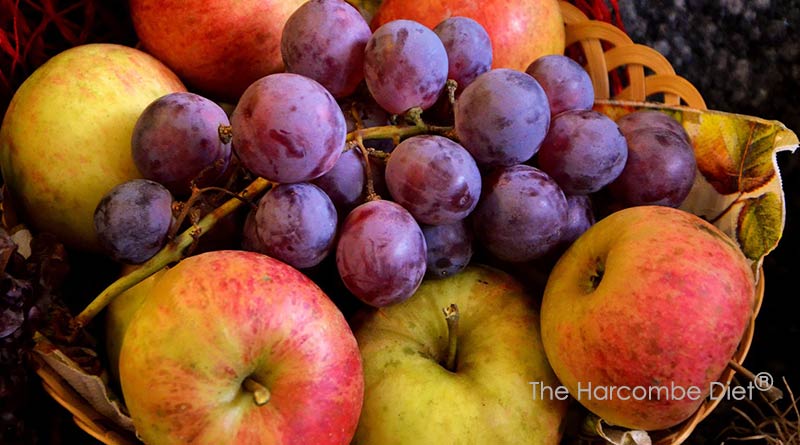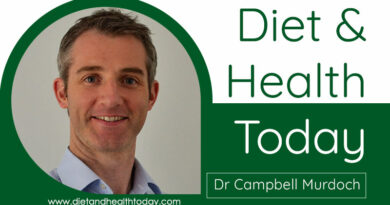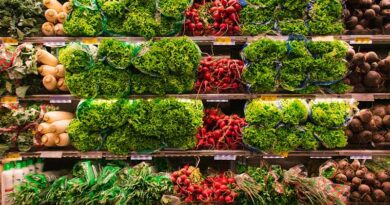The perfect 5-a-day

This is a follow-up to this post. A study came out on 1st April 2014 (no joke) suggesting that we need to revise the 5-a-day slogan and make it 7-a-day. I had a busy day starting with Nicky Campbell on BBC5 live; Shane on BBC Coventry; Dermot Murnaghan on Sky News and Eddie Mair on PM (16 mins in) and managed to write an 800 word article for The Mirror in between interviews.
My key points were as follows:
1) Five-a-day was invented at a meeting of fruit and veg companies at a meeting in California in 1991. The term has since been trademarked by the American National Cancer Institute. It was not evidence based at the time and for something to be evidence based, it needs to be based on evidence. That means the evidence needs to come before the slogan. A point that seems to escape every person who reiterates this myth as if it is fact. The full monty on five-a-day is here. Here are the findings from the EPIC study in 2010 showing that we couldn’t even establish a clear association, let alone causation, for the condition for which five-a-day is trademarked (cancer) after studying 500,000 people across 23 European locations for 8 years.
2) Fruit and vegetables are not the healthiest foods available. Why are they being singled out as the food items we should be putting such effort into consuming every single day?
3) If only we had put the same effort into promoting evidence based ‘super foods’ – the ones genuinely rich in all the nutrients that humans need to survive and thrive, we could actually have made a difference to human health since five-a-day was first coined.
Combining points 2 and 3, I submit the following tables into evidence. All information is openly available on this site. drawing from the United States Department of Agriculture’s National Nutrient Database for Standard Reference…
In the following two tables I have recorded:
– Essential fats (the term “essential” in nutrition means we must consume this substance – our body doesn’t make it);
– Complete protein (any food with a protein score over 100 provides complete protein – including the essential amino acids that we must consume. Any food with a protein score below 100 does not provide complete protein);
– 12 vitamins (the database doesn’t record biotin) and the main macro minerals and trace minerals. (Next to each vitamin and mineral is the US Recommended Dietary Allowance or “AI”, Adequate Intake, where an RDA is not given).
Table 1 has five foods that I would recommend as healthy – based on evidence of nutrient provision. Between them (and not always needing 100g for many nutrients to be acquired) they provide all the nutrients that humans need. Please note the nutrients that are most difficult to obtain. People should ideally consume 200g of oily fish each day to get close to the vitamin D and calcium requirements; the addition of steak to these five foods would be helpful to increase zinc intake.
Table 2 has the same information extracted for a typical five-a-day: apple, banana, orange, carrots and peas.
The yellow highlighter gives you a quick visual check of which food provides the most of each nutrient per 100g of product. This is why I describe liver as the most nutritious food on the planet. Please let me know if you find a food with essential fats and complete protein, which is richer in vitamins and minerals than liver.
Table 1
| (All per 100g of product) | Chicken Liver | Sardines | Eggs | Sunflower seeds | Kale |
| Essential Fats – omega 3 (mg) | 6 | 1,480 | 74 | 74 | 180 |
| Essential Fats – omega 6 (mg) | 486 | 3,544 | 1,148 | 23,048 | 138 |
| Protein Quality (100+ = complete protein) | 149 | 148 | 136 | 88 | 92 |
| Vitamins | |||||
| A Retinol (900 mcg) | 3,290 | 32 | 139 | 0 | 0 |
| A Carotene (assumed retinol equivalent) | 6 | 0 | 1 | 3 | 769 |
| B1 (Thiamin) (1.2 mg) | 0.3 | 0.1 | 0.1 | 1.5 | 0.1 |
| B2 (Riboflavin) (1.3 mg) | 1.8 | 0.2 | 0.5 | 0.4 | 0.1 |
| B3 (Niacin) (16 mg) | 9.7 | 5.2 | 0.1 | 8.3 | 1 |
| B5 (Pantothenic Acid) (5 mg) (AI) | 6.2 | 0.6 | 1.4 | 1.1 | 0.1 |
| B6 (1.7 mg) | 0.9 | 0.2 | 0.1 | 1.3 | 0.3 |
| Folate (400 mcg) | 588 | 12 | 47 | 227 | 29 |
| B12 (2.4 mcg) | 16.6 | 8.9 | 1.3 | 0 | 0 |
| C (90 mg) | 17.9 | 0 | 0 | 1.4 | 120 |
| D (600 IU) (AI) (*) | neg | 272 | 35 | 0 | 0 |
| E (15 mg) | 0.7 | 2 | 1 | 33.2 | 0 |
| K (120 mcg) (AI) | 0 | 2.6 | 0.3 | 0 | 817 |
| Minerals (M) | |||||
| Calcium (1,000 mg) (AI) | 8 | 382 | 53 | 78 | 135 |
| Magnesium (420 mg) | 19 | 39 | 12 | 325 | 34 |
| Phosphorus (700 mg) | 297 | 490 | 191 | 660 | 56 |
| Minerals (T) | |||||
| Copper (0.9 mg) | 0.5 | 0.2 | 0.1 | 1.8 | 0.3 |
| Iron (18 mg) | 9.0 | 2.9 | 1.8 | 5.2 | 1.7 |
| Manganese (2.3 mg) (AI) | 0.3 | 0.1 | 0.0 | 1.9 | 0.8 |
| Selenium (55 mcg) | 54.6 | 52.7 | 31.7 | 53.0 | 0.9 |
| Zinc (11 mg) | 2.7 | 1.3 | 1.1 | 5.0 | 0.4 |
* Data for vitamin D is in IU’s – International Units. The USA has recently revised recommended vitamin D intakes to be 15 mcg per day (from 10 mcg per day). This is equivalent to 600 IU.
Table 2
| (All per 100g of product) | Apple | Banana | Orange | Carrots | Peas |
| Essential Fats – omega 3 (mg) | 9 | 27 | 9 | 2 | 35 |
| Essential Fats – omega 6 (mg) | 43 | 46 | 23 | 115 | 152 |
| Protein Quality (100+ = complete protein) | 31 | 62 | 58 | N/A | 84 |
| Vitamins | |||||
| A Retinol (900 mcg) | 0 | 0 | 0 | 0 | 0 |
| A Carotene (assumed retinol equivalent) | 3 | 3 | 12 | 835 | 38 |
| B1 (Thiamin) (1.2 mg) | 0.0 | 0.0 | 0.1 | 0.1 | 0.3 |
| B2 (Riboflavin) (1.3 mg) | 0.0 | 0.1 | 0.1 | 0.1 | 0.1 |
| B3 (Niacin) (16 mg) | 0.1 | 0.7 | 0.4 | 1 | 2.1 |
| B5 (Pantothenic Acid) (5 mg) (AI) | 0.1 | 0.3 | 0.3 | 0.3 | 0.1 |
| B6 (1.7 mg) | 0.0 | 0.4 | 0.1 | 0.1 | 0.2 |
| Folic Acid (Folate) (400 mcg) | 3 | 20 | 34 | 19 | 65 |
| B12 (2.4 mcg) | 0.0 | 0.0 | 0.0 | 0.0 | 0.0 |
| C (90 mg) | 4.6 | 8.7 | 59.1 | 5.9 | 40 |
| D (600 IU) (AI) (*) | 0.0 | 0.0 | 0.0 | 0.0 | 0.0 |
| E (15 mg) | 0.2 | 0.1 | 0.2 | 0.7 | 0.1 |
| K (120 mcg) (AI) | 2.2 | 0.5 | 0.0 | 13.2 | 24.8 |
| Minerals (M) | |||||
| Calcium (1,000 mg) (AI) | 6 | 5 | 43 | 33 | 25 |
| Magnesium (420 mg) | 5 | 27 | 11 | 12 | 33 |
| Phosphorus (700 mg) | 11 | 22 | 23 | 35 | 108 |
| Minerals (T) | |||||
| Copper (0.9 mg) | 0.0 | 0.1 | 0.0 | 0 | 0.2 |
| Iron (18 mg) | 0.1 | 0.3 | 0.1 | 0.3 | 1.5 |
| Manganese (2.3 mg) (AI) | 0.0 | 0.3 | 0.0 | 0.1 | 0.4 |
| Selenium (55 mcg) | 0.0 | 1.0 | 0.0 | 0.1 | 1.8 |
| Zinc (11 mg) | 0.0 | 0.2 | 0.1 | 0.2 | 1.2 |
The fruit and veg five-a-day has traces of essential fats; no complete protein; no retinol (the form in which the body needs vitamin A – don’t assume that carotene can be converted); no B12 and no vitamin D (note also that D3 is only available in animal foods – D2 is the plant version). Not one nutrient RDA/AI can be provided by 100g of any of the fruit and veg – not even vitamin C.
We would need to eat 2,100 grams of carrots daily to get vitamin E (taking the best of the 5 sources of vitamin E). We would need to eat 2,300 grams of oranges daily to get enough calcium. We would need to eat 450 grams of peas daily to get our copper requirement – make that 1,200 grams to get our iron need.
One of the other points I made in interviews yesterday was the significant sugar content in fruit and veg. There are 3 grams of sugar in 100 grams of each of the five foods in Table 1. The 3 grams come entirely from the sunflower seeds. There are 41 grams of sugar (10 teaspoons) in 100 grams of each of the five foods in Table 2. In the Sky News Interview Katharine Jenner from Action on Sugar was ‘on the other side’ saying that we should eat more fruit and veg. She tried to discount the sugar issue. As the biochemist said in this programme, “sugar is sugar – the body doesn’t know what it came from.”
This is why I get seriously pissed off with five-a-day. It isn’t evidence based, never was and we are telling people to eat foods that can never compete with genuinely nutritious foods. To add insult to injury – the most nutritious foods are the ones that we demonise. I think that justifies the words pissed off!


